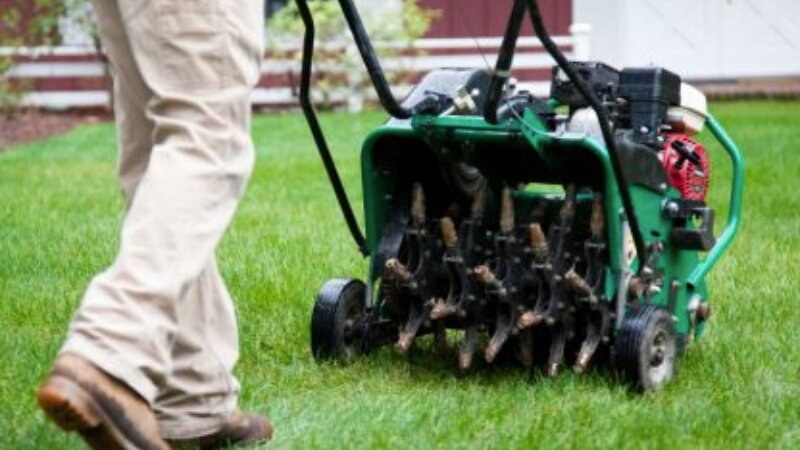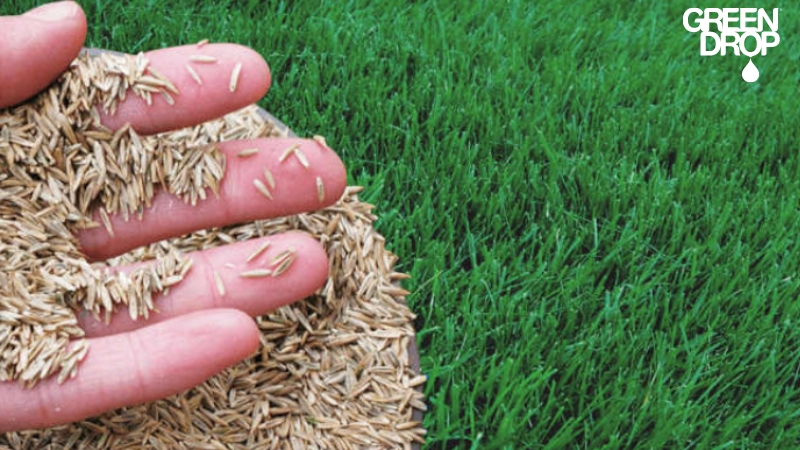Want Thicker, Healthier Grass by Spring? Start With Fall Aeration and Overseeding
Reading time: 6 minutesWant Thicker, Healthier Grass by Spring? Start With Fall Aeration and Overseeding
Some of us shut down all lawn care activities once the leaves start falling. But the ones with the best-looking grass come spring are the ones planning for fall aeration and overseeding right now.
This should ideally happen in early fall when temperatures are…comfortably cold, and not the freezing eye-burning cold we’re otherwise used to. Think above 10°C consistently for about a week.
So if you want thicker, stronger, greener grass next year without a full lawn redo, this is your window.
Here’s why fall aeration and overseeding is one of the best things you can do for your lawn, and exactly what to expect if you do it right.

Why Fall is A Good Time for Lawn Recovery
For cool-season turfgrass (the kind we grow here across the Prairies), it’s the ideal moment to rebuild, because:
- The soil is sort of warm (compared to the winters), which helps seeds germinate quickly.
- The air is cooler, so seedlings aren’t stressed by summer heat.
- Rainfall tends to be more consistent, which means fewer dry-out risks for tender seedlings.
- Fewer lawn pests are active, reducing the chances of new grass being chewed up before it’s established.
- Weeds aren’t as aggressive either, so new grass doesn’t have to compete as hard.
- Cool-season grasses love fall. This is their natural recovery period; it’s what they’re built for.
- Grass roots are still active, even if top growth is slowing.
That means your lawn can focus all its energy on building a strong root system instead of just looking green on the surface.
What Aeration Actually Does (And Why It Comes First)
Fall aeration might not be glamorous. You’ll see little plugs of soil littering your lawn afterward. But it’s the secret to helping your yard breathe and bounce back. And yes, we always aerate before we overseed. Otherwise, you’re just tossing seed on a closed-off surface. Aeration sets the stage so the new seed can actually take root.
Here’s what core aeration actually does:
- Relieves compaction. After a season of foot traffic, mowers, and dry soil, your lawn can get dense and tight, making it hard for roots to grow. Aeration opens things up.
- Improves water and nutrient flow. Those little holes help water soak deeper into the soil where roots can use it.
- Breaks up thatch. A thick layer of thatch can block air, water, and nutrients. Aeration helps reduce it naturally.
- Creates perfect conditions for seed-to-soil contact. This is critical. Without it, overseeding is just wishful thinking.
- Encourages deeper rooting. By loosening the soil, aeration allows roots to grow downward instead of sideways, building a stronger, drought-resistant lawn from the ground up.

Why Overseeding is the Next Logical Step
You don’t need to tear out your lawn to improve it. Overseeding lets you thicken up thin patches, repair summer damage, and future-proof your turf in one go. And when you do it in the fall, your new grass has months to settle in before facing next year’s challenges.
One thing to note though, germination only starts when soil temps are consistently above ~10°C. So make sure you’re checking the temperature forecast for at least the next week.
Best window: Late August to mid-September. By October, soil temps often dip below 10 °C (50 °F), which means grass seed germination slows or stops.
If you seeded early enough: New grass will establish roots before freeze-up.
If you seeded late: Don’t worry too much because seed can “sleep” in the soil over winter (dormant seeding) and germinate in spring once the soil warms.
Here’s why overseeding in the fall works:
- It fills in bare spots left behind by heat, drought, insects, or disease.
- It increases turf density, which naturally crowds out weeds.
- It boosts resilience. Adding new seed means introducing fresh, vigorous grass plants that are better equipped to handle weather swings.
- It adds genetic diversity. A mixed grass blend is better at fighting off pests and disease.
- It plants new seedlings that take root in the fall, so they’re ready to take off as soon as the snow melts.

What to Expect After Aeration + Overseeding
So you’ve booked your Green Drop service. The work’s done, the seed is down, and now… what?
It’ll look a bit rough at first.
You’ll see soil plugs from aeration, maybe a dusting of grass seed sitting on the surface, and the lawn might look messier than usual for a couple of weeks. That’s totally normal and temporary.
Germination takes time.
Cool-season grass seed can take 5–30 days to germinate, depending on the seed type, weather, and soil moisture. For example:
- Perennial ryegrass would take approximately 5–10 days. They’re fastest to sprout.
- Fine fescues take approximately 7–14 days
- Tall fescue takes about 7–12 days
- Kentucky bluegrass has the slowest growth approximately 14–30 days, but is the most hardy
In addition, if you see a few chilly days, dry weather, or you miss a watering day, expect things to take a bit longer.
Keep watering (but not too much).
Your lawn needs consistent moisture. Not daily drenching, but steady, deep watering every few days to keep the soil damp.
Early fall can still be dry, so keep watering lightly to keep the topsoil moist while seedlings establish.
As frost becomes regular and growth slows, taper off watering. By late October/early November, you can usually shut things down.
Don’t mow too soon.
Wait until the new grass reaches at least 3 inches tall before mowing to avoid tearing it out. And when you do mow, leave the clippings. They protect seedlings and return nutrients to the soil.
Results often show up in spring.
Some seedlings will pop now if conditions are ideal. But the real payoff comes next season when your lawn wakes up thicker, greener, and more resilient, all thanks to your smart fall prep.
Prairie Fall Lawn Checklist
Check forecast for a week. Are temperatures consistently above 10°C?
Aerate and overseed
Keep watering lightly until frost is consistent.
Fertilize in late September/early October (before soil freezes).
Keep mowing until growth stops; finish at 2–2.5”.
Clear or mulch leaves/debris.
Minimise traffic on lawns.
Common Mistakes to Avoid
A lot of homeowners try fall overseeding and get disappointed. Usually, it’s because of one of these mistakes:
- Waiting too long: Overseeding too close to the first frost means your seed may not germinate at all. Aim for early to mid-fall.
- Skipping aeration: Tossing seed on compacted soil is like throwing spaghetti at a wall. You need those holes for seed-to-soil contact.
- Bagging clippings afterward. Big mistake: Bagging pulls out surface seed before it’s had a chance to root. We always recommend mulching clippings during this period (unless you’re expecting heavy rain).
- Inconsistent watering: If the soil dries out, germination stops. If you go too wet, you risk fungal problems. Steady moisture wins.
- Mowing too early or too low: Cutting new seedlings before they’ve rooted can rip them right out. Let them get strong first.
Want Thicker, Healthier Grass Next Spring? Start Now.
Fall aeration and overseeding isn’t a bonus, it’s the baseline if you want that lush, golf-course lawn by April.
And you don’t need to do it alone. Green Drop makes it simple and results-focused. We prep your soil, give your grass room to breathe, and seed it with the exact blend your yard needs to thrive.
Whether you’re in Winnipeg, Calgary, Red Deer, Edmonton, Saskatoon, or Regina, book your fall aeration and overseeding today for a stunning green lawn.

